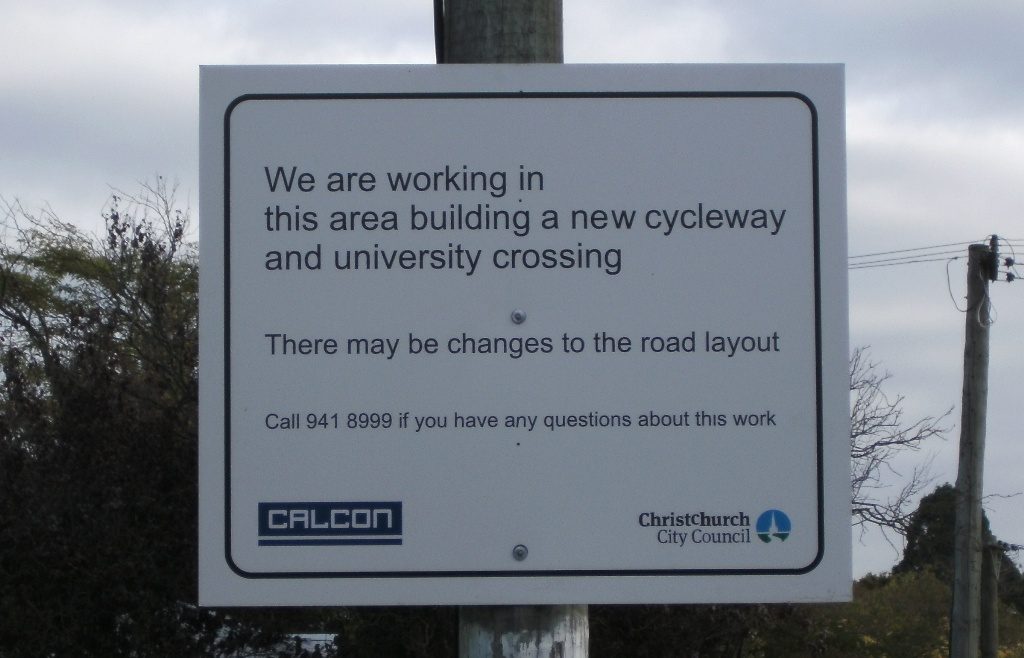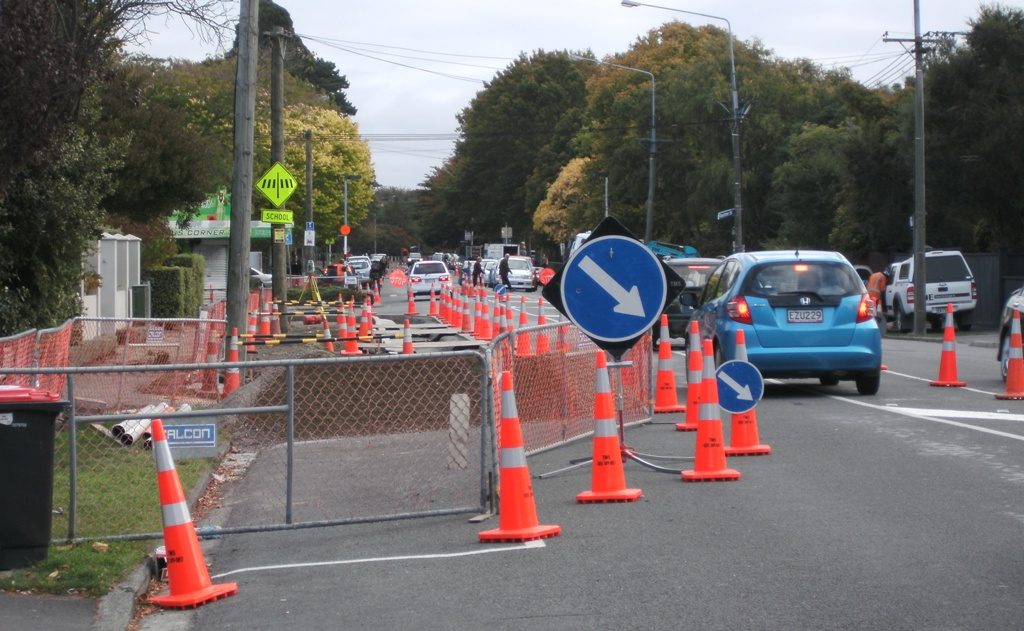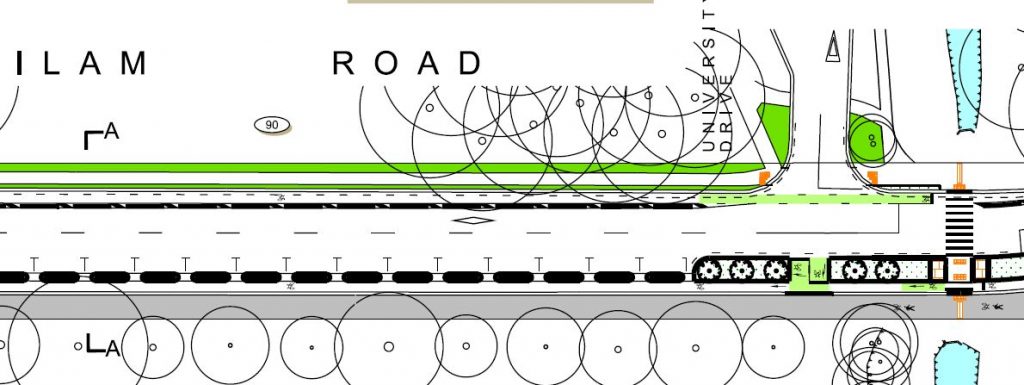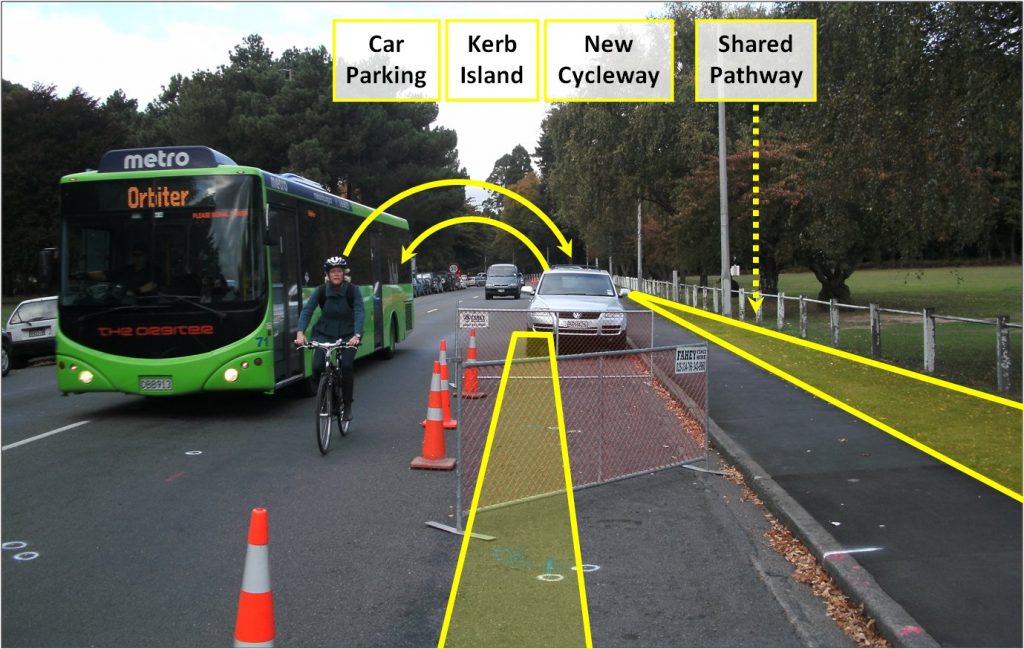UPDATE: See our latest post with pics following completion
Last year we brought you details of the Ilam Road project near the University of Canterbury, aiming to provide better facilities for both walking and biking alike. With the students currently away for term break, the contractors have been busy:

This project started out as a way to improve provision for the thousands of pedestrians who cross this part of Ilam Rd every day. But as it developed, the needs of people cycling were also recognised, and a highly innovative (well, for NZ) cycleway project came out of it too.

The initial proposal just featured shared off-road pathways and on-road cyclists having to mix it with traffic; a design that didn’t seem to please anyone. Thankfully the revised proposal was a much improved plan that provided some genuine options for “all ages and abilities” (see PDF of whole plan).

A key change was the removal of car parking on one side, which allowed more room to provide separation for cycling from traffic and parking by means of concrete kerbed islands. A wide shared pathway was also retained on one side for even less confident riders to stay clear of the road.

There’s still a bit of work to go, with Council estimating it will be June before it’s all completed. We’ll show you around once it’s all complete. But for now, you can start to envision how it might look:

What do you think of the Ilam Rd works?

Enlighten me. Is there still a “pinchpoint” along the section of Ilam Rd at Rountree St?
There are cycle lanes going across the Rountree St intersection. The end of the project at the Kirkwood Ave intersection arguably creates more of a pinch-point where these lanes end, although traffic can around you by using the painted median in the middle.
I think this is great. I hope it is the first of many to come!!!!
Looks like I may have to pay $200 to park at uni now..
I always parked my bike for free when I was studying at Canterbury University;)
How do cyclists going in the other direction fare? Do they use the shared pathway or just the normal narrow bit of road?
Joy, if you have a look at the plan you’ll see that there are small concrete kerb separators between the cycle lane and traffic lane for much of the length (i.e. like the other side, but without the car parking).
I don’t like it at all. I am a cyclist and travel pretty quickly, I am sure there will be accidents where pedestrians step off the kerb, through the cycle lane to wait on their island for the vehicle traffic, without really checking for cyclists. Plus I am annoyed that so many car parks were removed. The road is too narrow around the bus stop on the corner before Creyke Rd. What are cyclists supposed to do as they approach Creyke Rd, want to turn right and have to somehow check for traffic and weave between those stupid kerbed islands? I can envisage quite a few cyclists crashing into the kerbed island in that scenario. But lastly, what was it all really for? Was it a dangerous stretch for cyclists? I completely agree with the pedestrian crossings, but why not just leave it at that?
Oh, and another thing: where on earth am I supposed to park my car for sports on Saturday? I will now have to park at least 400 m away, and quite possibly more!
There’s still parking on one side; there’s a whole university car park across the road that’s hardly used on a Saturday. Or you could bike… 🙂
I prefer not to bike with my cricket gear! That bag is massive.
Don’t mean to go on, but … I Saw they had added some car parks today! On the other side of the cycle lane. Wouldn’t want to park there in anything bigger than a mini. Even then would want to fold the wing mirrors in for fear the buses would knock them off! It will be interesting watching cars parallel park there, they will have no option but to stop all traffic behind them. I don’t understand how the planners can’t see the problems with the design, it’s bizarre.
I cycle this route every day to school and back, and it was always a dangerous section for cyclists, especially when the buses passed at high speed. Since they have built the new cycleways I feel much safer. I would love to see this implemented all around Christchurch. Also regarding the car parks, I thought they seemed small too, until I saw them today with cars parked in them, there is heaps of room on all sides, and the problem of stopping traffic behind you when parallel parking is has always been a problem.
I have now used the Ilam Rd cycle route trial several times, both as a car driver and as a cyclist. I don’t like it because of the concrete kerb sleepers, which I believe makes the route less safe than a standard road.
Pros:
1. Great to see something being done to make cycle commuting safer.
2. I like the painted car door separator beside car parks.
Cons:
1. The concrete separator kerbs are much too large. They are a danger to cars and cyclists alike. Their height makes them a serious crash hazard, and their width wastes too much of the road width.
2. They are spaced far too close together, so that it is impossible to pass by briefly moving into the car lane. Unlike cars, cycles travel at vastly differing speeds, so passing must be easy and safe.
3. The narrowing of the road means that cycles will be forced to use the cycleway even if it is more dangerous for them, otherwise car drivers will be understandably irate.
4. On straight sections of road the main hazards are from driveways or side streets, and car doors. These concrete kerb separators do not address either problem.
5. The costs are outrageous. Money should be spent instead on making intersections safer. This is where the real hazards lie.
6. The concrete kerb sleepers are incredibly ugly.
Personally, if this system is rolled out across the city I will be forced to commute using other unmodified routes, and chance my luck amongst the cars. Not the desired outcome.
The whole issue can be resolved by using the low Riley separators, especially with plastic posts on corners, similar to the trials on Strickland and Kotare streets. These have had resounding support from all users. They work perfectly, providing a reminder of the separation to both cyclists and car drivers, without insulting car drivers or endangering cyclists.
Then let’s start focusing on making intersections safe.
If those curbs were bigger and radiused we wouldn’t need chains, underground pipes? Until then trail bikes often make most sense.
I used to be a uni student, and remember what it was like to cycle along Ilam Rd in rush hour. It wasn’t the safest place to be.
Since the upgrade I have only gone along there once, and something really struck me about how the ‘cycleway’ has been made. It’s built just like a footpath. It is a very uneven surface in places, and includes an unnecessarily tight corner which feels like it was designed by someone without understanding of the speeds that cyclist travel at. In terms of speed, cyclists are more similar to motorists than pedestrians, so the separation between cyclists and pedestrians should be greater than that between cyclists and motorists, which is something the Ilam Rd cycleway goes completely against in places.
Even with the protection from motorists that the concrete separators provide, I prefer the open and flat cycle lanes of the main arterial routes to what has been installed on Ilam Rd.
Having now used the route several times a day for several months, would suggest it has been a partial success, but there is plenty of room for improvement. The quality of the construction is terrible, and much of it is falling to bits now.
I like the design, overall, thogh it is a shame it had to swap over near Ilam school with that awkward wiggle.
As noted by Stephen, the concrete seperators are a bit of a fail, for multiple reasons. I hope we don’t see any more of them. The plastic seperators would have been better, though I don’t think they look great either.
My favourite option is a continuous row of red pavers, with a slight rise and a nicely tapered concrete edge, though I guess this would be the most expensive approach. Some planters with a decent (eg 20m) seperation between them might have been a better option for this side.
I like the cut-out at the corner of Montana Ave, but the designer messed up the geometry a bit, so I always end up going around the footpath side of one of the islands, which obviously wasn’t what she intended.